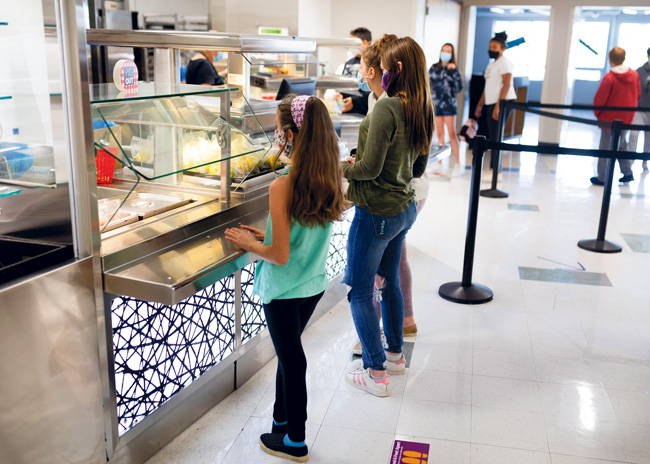Flexible design, a rethinking of service flow and multiuse equipment are all making headway in school foodservice programs.
The pandemic did (and didn’t) change things already happening in K-12 school foodservice. For one, labor was becoming an issue even before the pandemic. All the pandemic did was amplify this pain. “We have 85 to 90 open positions; normally we have 30 to 40 around this time of year,” says Dan Ellnor, SNS, CPFS, PCQI, assistant director, school and nutrition services for Jefferson County Public Schools in Louisville, Ky. “We’ve been paying $3.50 per hour on top of salary to keep employees.” Luckily, Ellnor oversees a central production kitchen he helped build more than two decades ago that allows Jefferson County Public Schools to centralize its foodservice operation and supply the various schools with batch production. But not everyone has this luxury.
That’s why flexible design and equipment that saves on labor and space will become the wave of the future in school foodservice, according to John Pace, founder of JMK Foodservice Consulting & Design LLC, based in Texas. There’s a lot of talk about multiuse equipment in the back of the house, but Pace says, “the turnover rate in K-12, and especially in big districts, is very high, and it’s hard to keep people trained on specialty equipment like combi ovens versus a double convection oven with a dial and ‘on’ button. The same goes for steamers.”
Equipment items like steamers and convection ovens still tend to be the main workhorses of a school foodservice kitchen. “There was a huge push for combis years back, and I come from a chef background and love them, but I’ve seen them wane in the last few years from people just not using them,” Ellnor says. “If [school districts] can keep the manager trained and that person can train their staff, [combi ovens are] great. You can put pictures of the food, and employees can go and just press a button.” In that sense, they can be excellent labor-saving pieces.
Making greater use of vertical space is all the rage when it comes to space savings at the school level. “I’m seeing a lot more equipment that goes vertical. Space is precious, and if we can double-stack a frost top or put a hot frost over a cold well or even just an ambient snack rack over another piece of equipment, that helps a lot,” Pace says.
Even in the servery, stacking shelves and using higher display merchandisers (at the middle and high school level where students are taller), helps schools expand their offerings without expanding their footprint. “Where we used to have those old-school milk boxes in a cold well by the cashier, now we can offer a lot more through the use of refrigerated merchandisers,” says Pace.
There are more options for refrigerated merchandisers these days, says Pace, including vertical ones that can even be built onto or adjacent to a serving line — some with crates on the bottom for those milk boxes. Other shelves might hold bottles of water and juice, fresh salads and other prepackaged food. It’s a much “classier” look too, akin to the university level, Ellnor says.
 One of the goals for school foodservice design at Jefferson County Public Schools in Colorado is for students to feel like they are walking into a cool place to eat when they enter the servery. Photo courtesy of Catherine Jeter Photography
One of the goals for school foodservice design at Jefferson County Public Schools in Colorado is for students to feel like they are walking into a cool place to eat when they enter the servery. Photo courtesy of Catherine Jeter Photography
Rethinking Service Flow
Many of Pace’s school clients have sought to rethink flow in the servery, especially during the pandemic. “With COVID, everything had to be prepackaged with no self-service at all, and that changed the delivery method,” he says. Though self-serve has come back in many operations, that desire for prepackaged foods remains for speed and convenience purposes. Again, that’s where the refrigerated display units can help.
The trends in school foodservice follow those of higher education, however not everything can be university style. “Notoriously, most serveries still have point-of-sale at end of line for security reasons,” Pace says. “You might have multiple stations or outlets in a high school, but each will have a point of sale.”
Pace estimates that less than 5% of his school foodservice clients over the years have strayed away from close-proximity POS. The most recent example was a magnet school in Arlington, Texas, that wanted to reward the kids with a more university-style design for having been accepted to the prestigious school.
Presentation Matters
“The biggest thing I’ve seen in terms of serving students in the last 15 years is color,” Pace says. Gone are the days of plain stainless steel — in with the laminates, free-form, even perforated stainless-steel fronts for more visual interest and curb appeal. “A lot of manufacturers now provide options like free-form raised panels, backlit panels with different patterns and nicer back boards with tiling,” he says. “We can run tile from the floor all the way up to the cold base, and it’s all hermetic and looks like it’s meant to be there.”
Glass and transparency in design also help enhance the visual appeal of a school foodservice operation. “Instead of a wall where you go in and out, we’re seeing a lot of glass storefront-like design,” Pace says. “We’re seeing a lot more use of curved glass — less institution or prison-like. Taxpayers are paying for this with the public schools. Even though parents don’t go to school every day, they do go to PTA meetings and might see their kids in a play. As a taxpayer myself I want my kids engaged and excited about eating at their school.”
Presentation is key when it comes to school foodservice and encouraging kids of all ages to reach for the fruits and veggies. For Scott Reitano, principal, Reitano Design Group, it’s important to think about what the counters will look like and how the operation will present healthy food, especially at the elementary school level when kids are learning about and trying more foods. Reitano is aware that many students might want to immediately reach for the pizza and fries, so by designing the serving counter with more flexibility, foodservice directors can choose to set up trays of fresh fruit and vegetables at the beginning of the line to encourage healthy choices.
At the middle school level, Reitano’s all about “control of the tray.” “If you put something on a tray, you’re more likely to eat it so offering an enticing variety is important.”
At the high school level, Reitano’s team constantly researches trends and looks for feedback from the students. “We had a school tell us their kids were never going to eat sushi, but when we did a focus group with the students, when I asked what’s one thing you would eat that’s not currently on the menu, at least three people said sushi.” Reitano helped one school even put in a fitness bar offering smoothie bowls and other healthy options near the athletics facility so students could have something nutritious to eat before practice or games.
Then there’s the poor salad bar. COVID-19 did a number on one of the most popular features among contemporary serveries. There are still no full-service salad bars at most of Reitano’s and Pace’s clients.
“Even in larger school districts, I don’t see a lot of salad bars because the foodservice directors say they’re just not ready for it,” says Pace, who’s heard horror stories of rusted metal batteries and other inedible items ending up in the salad fixings. Not to mention, with continuing labor challenges, keeping these bars stocked and tidy among kids practically requires a full-time employee. Instead, more schools are turning to prepackaged salads displayed in those refrigerated cases for an easy and convenient, fresh food option.
Distributed Dining
Realizing the proliferation of mobile ordering and how many members of Gen Z (and Gen Alpha, which is next) prefer the convenience of getting their food when and where they want it, districts today are exploring their options for distributed dining. This allows these operators to feed students at different times and locations. At the K-12 level, instead of setting to-go food in cubbies for self-pickup (like you might see at a fast-casual restaurant), Reitano encourages placing the pickup shelves behind the cashier, who has the control to provide them to the students. “Or maybe there are multiple places for serving students,” he says. Reitano points to one of his middle school projects in North Carolina, where a satellite serving line with mostly grab-and-go foods and a common area was built on the second floor to feed the upper-level students separately from the lower-level students downstairs.
“Maybe you could put a cafe in or near a media center or library space,” Reitano says, who has explored the idea of multiple concessions areas with his larger high school clients.
When it comes to school foodservice of the future, thinking outside the box and understanding how kids today eat and what they want to eat will be the name of the game.

Top Tips
 Here, Scott Reitano, principal of Reitano Design Group, offers ways to boost healthy habits through foodservice design.
Here, Scott Reitano, principal of Reitano Design Group, offers ways to boost healthy habits through foodservice design.
Elementary School: Form Healthy Habits
- Introduce choices
- Increase exposure to vegetables
- Conduct regular taste tests
- Presentation is subliminal
Middle School: Reinforce Healthy Habits
- Increase choices
- Introduce new spices and seasonings
- Ask for menu feedback and input
- Use more descriptive menus
- Sample new items
- Presentation matters
High School: Respect the Palate of the Older Student
- Change the experience
- Give the student control of the tray
- Look for an authentic experience
- Deliver made-to-order items
- Presentation is key
Looking for more? Check out these articles:
Lakewood, Colo., School District Plans for Central Production Kitchen
K-12 Foodservice Learning from Established Commissary Model in Louisville, Ky.



